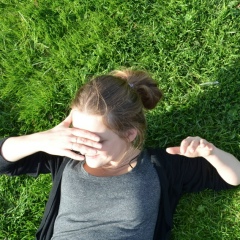Васнецов В.М. "После побоища Игоря Святославича с половцами"
1880 год, масло, холст, Третьяковская галерея.
В 1878-1880 годах Васнецов пишет большое монументальное полотно, посвященное неудачному походу новгород-северского князя Игоря Святославича на половцев ранней весной 1185 года. Тогда на поле боя полегли многие русские воины, а сам князь попал в плен.
Картина писалась в Москве. После возвращения из Франции Васнецов поселяется в древней столице и вместе с Поленовым увлеченно зарисовывает русскую старину.
Важную эмоциональную роль выполняет пейзаж-настроение. На зеленом лугу, покрытому поникшими к вечеру травами и цветами, лежат тела убитых воинов – русских и половцев. Нет ни страданий, ни крови, ничего, способного вызвать отторгающее чувство ужаса и содрогания. Погибшие в сражении как будто уснули околдованным сном. Из-за мглистой пелены горизонта восходит кровавый диск луны. Над телами убитых с клекотом сцепились орлы — символы отошедшей битвы. Художник, окончивший семинарию, не мог не знать слова Матфея: «Ибо, где будет труп, там соберутся орлы» (Матф. 24:28).
Картина была выставлено на VIII выставке передвижников в 1880-м году и сначала не получила зрительских симпатий. Мнения были противоречивые, сам Виктор Михайлович констатировал: «Перед моей картиной стоят больше спиной».
Мясоедов, определявший задачи искусства в реалистическом воспроизведении действительности, решительно протестовали против картины Васнецова. Негативно отнесся к ней и Стасов. Глубже других проник в суть картины выдающийся педагог Чистяков, некогда учивший Васнецова. Он увидел в ней саму Древнюю Русь и в письме к художнику восклицал: «Самобытным русским духом пахнуло на меня!» Черту под спорами подвел Третьяков: он приобрел картину для своей галереи непосредственно с выставки.
Современная критика упрекала Васнецова в идеализованной трактовке поля боя. Молодому художнику ставили в вину противоречия картинных образов исторической правде. Но самого автора влекла не столько достоверность фактологии, сколько художественная интерпретация древнего поэтического текста. Васнецовское живописное повествование напрямую соотносится с вербальной метафорой из «Слова»: «Ту пир докончаша храбрые русичи: сваты попоиша и сами полегоша за землю русскую. Ничеть трава от жалости». Пафос картины в просветленной трагедии, в благородстве и красоте героической смерти за родную землю.
http://vk.com/okonnaya_galereya
1880 год, масло, холст, Третьяковская галерея.
В 1878-1880 годах Васнецов пишет большое монументальное полотно, посвященное неудачному походу новгород-северского князя Игоря Святославича на половцев ранней весной 1185 года. Тогда на поле боя полегли многие русские воины, а сам князь попал в плен.
Картина писалась в Москве. После возвращения из Франции Васнецов поселяется в древней столице и вместе с Поленовым увлеченно зарисовывает русскую старину.
Важную эмоциональную роль выполняет пейзаж-настроение. На зеленом лугу, покрытому поникшими к вечеру травами и цветами, лежат тела убитых воинов – русских и половцев. Нет ни страданий, ни крови, ничего, способного вызвать отторгающее чувство ужаса и содрогания. Погибшие в сражении как будто уснули околдованным сном. Из-за мглистой пелены горизонта восходит кровавый диск луны. Над телами убитых с клекотом сцепились орлы — символы отошедшей битвы. Художник, окончивший семинарию, не мог не знать слова Матфея: «Ибо, где будет труп, там соберутся орлы» (Матф. 24:28).
Картина была выставлено на VIII выставке передвижников в 1880-м году и сначала не получила зрительских симпатий. Мнения были противоречивые, сам Виктор Михайлович констатировал: «Перед моей картиной стоят больше спиной».
Мясоедов, определявший задачи искусства в реалистическом воспроизведении действительности, решительно протестовали против картины Васнецова. Негативно отнесся к ней и Стасов. Глубже других проник в суть картины выдающийся педагог Чистяков, некогда учивший Васнецова. Он увидел в ней саму Древнюю Русь и в письме к художнику восклицал: «Самобытным русским духом пахнуло на меня!» Черту под спорами подвел Третьяков: он приобрел картину для своей галереи непосредственно с выставки.
Современная критика упрекала Васнецова в идеализованной трактовке поля боя. Молодому художнику ставили в вину противоречия картинных образов исторической правде. Но самого автора влекла не столько достоверность фактологии, сколько художественная интерпретация древнего поэтического текста. Васнецовское живописное повествование напрямую соотносится с вербальной метафорой из «Слова»: «Ту пир докончаша храбрые русичи: сваты попоиша и сами полегоша за землю русскую. Ничеть трава от жалости». Пафос картины в просветленной трагедии, в благородстве и красоте героической смерти за родную землю.
http://vk.com/okonnaya_galereya
Vasnetsov V.M. "After the battle of Igor Svyatoslavich with the Polovtsy"
1880, oil on canvas, Tretyakov Gallery.
In 1878-1880, Vasnetsov wrote a large monumental canvas dedicated to the unsuccessful campaign of the Novgorod-Seversky Prince Igor Svyatoslavich against the Polovtsy in early spring of 1185. Then, many Russian soldiers were killed on the battlefield, and the prince himself was captured.
The picture was painted in Moscow. After returning from France, Vasnetsov settled in the ancient capital and, together with Polenov, enthusiastically sketched Russian antiquity.
An important emotional role is played by the landscape mood. On a green meadow, covered with grass and flowers that have fallen towards evening, the bodies of the killed warriors — Russians and Polovtsy — lie. There is no suffering, no blood, nothing that can cause a rejecting feeling of horror and shudder. Those who died in the battle seemed to fall asleep with a bewitched sleep. Because of the hazy veil of the horizon rises the bloody disk of the moon. Over the bodies of those killed with a scream, eagles grappled - the symbols of the withdrawal of the battle. The artist, who graduated from the seminary, could not fail to know Matthew's words: “For wherever the corpse is, eagles will gather there” (Matthew 24:28).
The painting was exhibited at the VIII exhibition of the Wanderers in 1880 and at first did not receive audience sympathy. Opinions were contradictory, Viktor Mikhailovich himself stated: “My back is standing in front of my picture”.
Myasoedov, who defined the tasks of art in realistic reproduction of reality, resolutely protested against Vasnetsov’s painting. Stasov also reacted negatively to her. Deeper than others, the outstanding teacher Chistyakov, who had once taught Vasnetsov, penetrated the essence of the picture. He saw in it Ancient Russia itself and in a letter to the artist exclaimed: “It smelled of me with an original Russian spirit!” Tretyakov drew a line under the controversy: he acquired a painting for his gallery directly from the exhibition.
Modern criticism reproached Vasnetsov for an idealized interpretation of the battlefield. The young artist was accused of contradictions in the images of historical truth. But the author himself was attracted not so much by the reliability of factology as by the artistic interpretation of an ancient poetic text. Vasnetsov’s pictorial narrative directly correlates with the verbal metaphor from The Word: “Tu fe dokonchasha brave rusichi: matchmakers and polegosh themselves for Russian land. Nichit grass from pity. " The pathos of the picture is in enlightened tragedy, in the nobility and beauty of a heroic death for their native land.
http://vk.com/okonnaya_galereya
1880, oil on canvas, Tretyakov Gallery.
In 1878-1880, Vasnetsov wrote a large monumental canvas dedicated to the unsuccessful campaign of the Novgorod-Seversky Prince Igor Svyatoslavich against the Polovtsy in early spring of 1185. Then, many Russian soldiers were killed on the battlefield, and the prince himself was captured.
The picture was painted in Moscow. After returning from France, Vasnetsov settled in the ancient capital and, together with Polenov, enthusiastically sketched Russian antiquity.
An important emotional role is played by the landscape mood. On a green meadow, covered with grass and flowers that have fallen towards evening, the bodies of the killed warriors — Russians and Polovtsy — lie. There is no suffering, no blood, nothing that can cause a rejecting feeling of horror and shudder. Those who died in the battle seemed to fall asleep with a bewitched sleep. Because of the hazy veil of the horizon rises the bloody disk of the moon. Over the bodies of those killed with a scream, eagles grappled - the symbols of the withdrawal of the battle. The artist, who graduated from the seminary, could not fail to know Matthew's words: “For wherever the corpse is, eagles will gather there” (Matthew 24:28).
The painting was exhibited at the VIII exhibition of the Wanderers in 1880 and at first did not receive audience sympathy. Opinions were contradictory, Viktor Mikhailovich himself stated: “My back is standing in front of my picture”.
Myasoedov, who defined the tasks of art in realistic reproduction of reality, resolutely protested against Vasnetsov’s painting. Stasov also reacted negatively to her. Deeper than others, the outstanding teacher Chistyakov, who had once taught Vasnetsov, penetrated the essence of the picture. He saw in it Ancient Russia itself and in a letter to the artist exclaimed: “It smelled of me with an original Russian spirit!” Tretyakov drew a line under the controversy: he acquired a painting for his gallery directly from the exhibition.
Modern criticism reproached Vasnetsov for an idealized interpretation of the battlefield. The young artist was accused of contradictions in the images of historical truth. But the author himself was attracted not so much by the reliability of factology as by the artistic interpretation of an ancient poetic text. Vasnetsov’s pictorial narrative directly correlates with the verbal metaphor from The Word: “Tu fe dokonchasha brave rusichi: matchmakers and polegosh themselves for Russian land. Nichit grass from pity. " The pathos of the picture is in enlightened tragedy, in the nobility and beauty of a heroic death for their native land.
http://vk.com/okonnaya_galereya

У записи 4 лайков,
0 репостов.
0 репостов.
Эту запись оставил(а) на своей стене Игорь Пюльзе
























